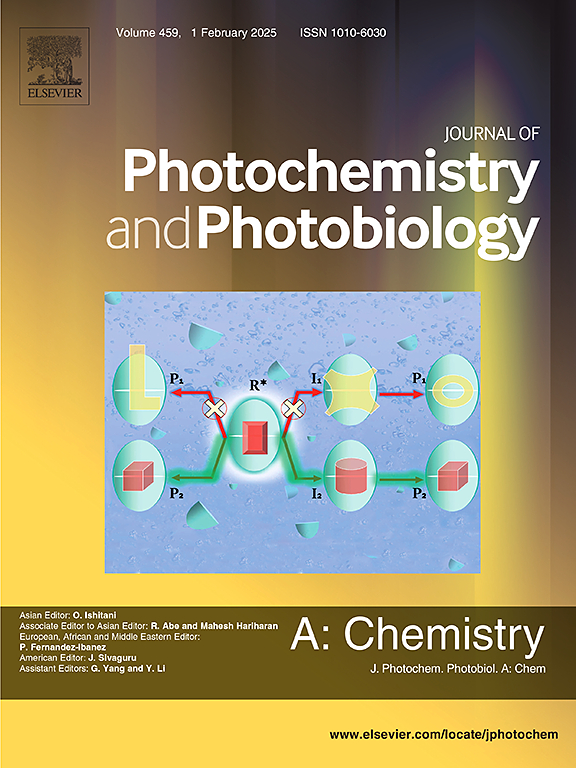A water-soluble copper(II) complex fluorescent probe for high-sensitive and selective detection of endogenous H2S
IF 4.1
3区 化学
Q2 CHEMISTRY, PHYSICAL
Journal of Photochemistry and Photobiology A-chemistry
Pub Date : 2025-03-19
DOI:10.1016/j.jphotochem.2025.116403
引用次数: 0
Abstract
H2S has been identified as a third gasotransmitter involved in bio-modulation pathways. However, the low concentration of endogenous H2S makes it difficult to trace and detect. In this study, a net charged and water-soluble copper(II) complex, Cu-L, is reported as an endogenous H2S detector by utilizing a fluorescence on–off–on strategy. The luminescence of ligand L (a DNS-modified DO2A derivant), which is quenched due to Cu2+ coordination, can be effectively and selectively relumed within seconds in the presence of H2S. Meanwhile, Cu-L has been successfully employed for exogenous and endogenous H2S imaging and neither Cu-L nor L shows toxicity at concentrations up to 50 μM. Moreover, Cu-L can trace endogenous H2S concentration fluctuation by treating cells with different concentrations of S-propargyl-cysteine (SPRC), an endogenous H2S modulator. Therefore, Cu-L holds the potential for H2S detection both in vitro and in cell.

一种高灵敏度、高选择性检测内源性H2S的水溶性铜(II)复合物荧光探针
H2S已被确定为参与生物调节途径的第三种气体递质。然而,由于内源H2S浓度较低,使其难以追踪和检测。在这项研究中,一种带净电荷的水溶性铜(II)配合物Cu-L利用荧光开关策略作为内源性H2S检测器。配体L(一种dns修饰的DO2A衍生物)的发光由于Cu2+配位而猝灭,在H2S存在下可在数秒内有效且选择性地重新发光。同时,Cu-L已成功用于外源和内源H2S成像,Cu-L和L在50 μM浓度下均未显示毒性。此外,Cu-L可以通过用不同浓度的s -丙炔半胱氨酸(一种内源性H2S调节剂)处理细胞来追踪内源性H2S浓度的波动。因此,Cu-L在体外和细胞内都具有检测H2S的潜力。
本文章由计算机程序翻译,如有差异,请以英文原文为准。
求助全文
约1分钟内获得全文
求助全文
来源期刊
CiteScore
7.90
自引率
7.00%
发文量
580
审稿时长
48 days
期刊介绍:
JPPA publishes the results of fundamental studies on all aspects of chemical phenomena induced by interactions between light and molecules/matter of all kinds.
All systems capable of being described at the molecular or integrated multimolecular level are appropriate for the journal. This includes all molecular chemical species as well as biomolecular, supramolecular, polymer and other macromolecular systems, as well as solid state photochemistry. In addition, the journal publishes studies of semiconductor and other photoactive organic and inorganic materials, photocatalysis (organic, inorganic, supramolecular and superconductor).
The scope includes condensed and gas phase photochemistry, as well as synchrotron radiation chemistry. A broad range of processes and techniques in photochemistry are covered such as light induced energy, electron and proton transfer; nonlinear photochemical behavior; mechanistic investigation of photochemical reactions and identification of the products of photochemical reactions; quantum yield determinations and measurements of rate constants for primary and secondary photochemical processes; steady-state and time-resolved emission, ultrafast spectroscopic methods, single molecule spectroscopy, time resolved X-ray diffraction, luminescence microscopy, and scattering spectroscopy applied to photochemistry. Papers in emerging and applied areas such as luminescent sensors, electroluminescence, solar energy conversion, atmospheric photochemistry, environmental remediation, and related photocatalytic chemistry are also welcome.

 求助内容:
求助内容: 应助结果提醒方式:
应助结果提醒方式:


